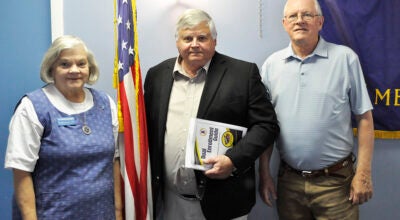Drought conditions hamper hay production
Published 8:48 pm Friday, June 17, 2011
With a couple of days of rain in many areas of the county, the continuing dark skies are the prettiest sight that farmers have seen in about two months.
But Goshen farmer Steve Stroud said the recent rain is not an indication that the drought is over.
“The rain has been enough to perk the grass up a bit but, if the sun comes out and the temperatures hit around 100 degrees, then the one-inch plus rainfall will be soaked up in two or three days,” Stroud said. “And, we’ll be dry again. We’re proud of this rain and hope that it doesn’t let up. We need to get some good rains often to really do any good.”
Stroud said that he’s gotten plenty of sunshine over the last two months but he’s not made any hay.
“The first spring cutting was good,” Stroud said. “We had a nice warm February and some good rain but, since then, almost nothing.”
During the past eight weeks, Stroud said he had only been blessed with one-tenth of an inch of rain.
“I’d gotten about an inch and a half before the tornadoes hit Alabama on April 27 but then the temperature dropped to 40 degrees,” he said. “It cooled so fast the rain didn’t do the fields any good. So, you might say the only rain that I’d gotten until Friday had been that one-tenth of an inch. And that’s not much rain any way that you look at it.”
Stroud said his hay fields are up about three to four inches and brown.
“I’ve never seen drought conditions this severe. We’ll have to have two or three good, soaking rains to do any good at all and I don’t even know if that would turn things around now.”
Stroud has no water storage on his property. The creek that runs through his land is almost dry so the possibility of irrigating is next to none.
“I’d have to drill a well and that’s very expensive along with the cost of putting in an irrigation system,” he said. “I don’t know if that would be cost effective. I guess it would have paid off to have an irrigation system this year.”
Stroud said that the second year he was in vegetable farming, there was a six-week period without rain.
“But until Friday, it had been two months and the weather was so hot and that made it worse,” he said. “It looks like every three years we go through something like this. I’ve never seen it this bad as it’s been this year.”
Stroud is also a cattle farmer and his animals are feeling the heat.
“The cows have eaten everything in the pasture and they’ve been out there nibbling but the grass is dry like cured hay,” Stroud said.
The difference between dry grass in the fields and baled hay is tremendous, Stroud said.
“There’s no photosynthesis taking place in the fields,” he said. “When we cut hay, photosynthesis has put nutrients in the hay and those nutrients are stored. Right now, there are no nutrients in the grass.”
If the drought conditions continue, Stroud said cattle farmers will probably begin to sell off some of their herd.
“There won’t be any hay left for the fall,” he said. “We’ll be crying and hurting for hay. But if this high pressure will get off us and we could get some soaking rains, we could make some hay. We’ll have to wait and see.”
On the other side of the county, Joe Murphy is also waiting to see if the recent rains will make a difference.
“The harsh drought coupled with the high temperatures is going to require more than a few showers,” Murphy said. “This heat is putting a lot of stress on the animals. We’re having late July and August weather in June.”
Murphy said he sold between around 70 brood cows out of his herd last year so his numbers are lower and that’s helping the hay shortage.
“The first cutting of hay played out in May and I’m starting to see the body mass of my cows come down,” he said. “And, they’re not likely to breed back as quick under these conditions so the drought has a lot of far reaching effects.”
When hay fields are not producing like normal, that puts the farmer in the position of having to supplement the cows with coming winter-feed.
Murphy also operates poultry houses and high temperatures and high humidity have an effect on the birds but the cooler nights offer a little recovery from the heat.
“The main effect on the birds right now is the heat and the main effect on the farmer is the high cost of utilities,” he said.
“When you have extreme heat or cold, the utilities go up at the poultry houses just like everywhere else. If there’s a good thing about the drought and birds, it’s that they don’t depend on grass.”





